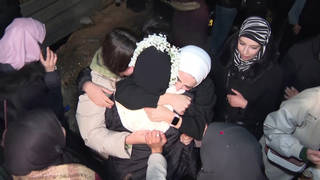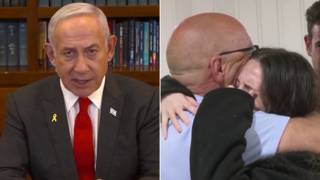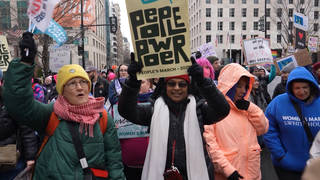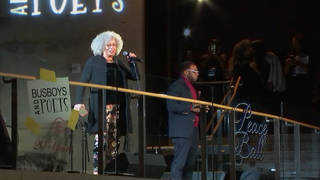
Related
Guests
- Mark Potoksenior fellow at the Southern Poverty Law Center, which has been tracking Frazier Glenn Miller for years.
- David Pakmanhost of The David Pakman Show. He interviewed Frazier Glenn Miller in 2010.
Notorious white supremacist Frazier Glenn Miller has been charged with killing three people at two Jewish community sites in Kansas. Miller, also known as Frazier Glenn Cross, has openly railed against Jews and African Americans for decades. He served three years in prison on weapons charges and an assassination plot, but avoided a longer sentence after testifying against other white supremacists. Miller claims to have been an FBI informant, and the federal government reportedly shielded him in the early 1990s as part of the witness protection program — the possible source of his multiple names. We are joined by two guests who have tracked Miller for years: Mark Potok, a senior fellow at the Southern Poverty Law Center, which tracks hate groups, and broadcaster David Pakman, who interviewed Miller in 2010.
Transcript
AMY GOODMAN: The man accused of killing three people at two Jewish community sites in Kansas made his first court appearance Tuesday by video conference. Frazier Glenn Miller, also known as Frazier Glenn Cross, has been charged with capital murder for killing 14-year-old Reat Underwood and his grandfather, William Corporon, outside a Jewish community center Sunday. He also faces a first-degree murder charge for killing Terri LaManno, who was visiting her mother at a nearby retirement complex.
Miller is a notorious white supremacist who had openly railed against Jews and African Americans for decades. He is the founder and former “grand dragon” of the paramilitary-style Carolina Knights of the Ku Klux Klan. In 1986, after forming the White Patriot Party, he was convicted of violating the terms of a court order settling a lawsuit by the Southern Poverty Law Center. He disappeared while out on bond and was later caught with other Klansmen and a stash of weapons. Miller went on to serve three years in prison on weapons charge and for plotting the murder of Morris Dees, the founder of the Southern Poverty Law Center. He reached a deal with federal prosecutors to testify against other white supremacists in a 1988 sedition trial.
This is Frazier Glenn Miller speaking in 1986 at a meeting of far-right leaders. It’s from the documentary Blood in the Face. A warning: This is filled with hateful language.
FRAZIER GLENN MILLER: I’m going down the street marching, and I got my bullhorn out there, and I yell out, “We thought y’all had some niggers down here! Where are they at?” And we got about two more blocks, and I seen where they was at. They were about eight deep on each side of the street. And we marched right in the middle of them, but we didn’t have trouble. They didn’t attack anybody; they just jumped up and down on the street. Have you ever seen monkeys when they get excited, how they jump up and down?
AMY GOODMAN: That was the white supremacist Frazier Glenn Miller speaking in 1986. The Kansas City Star reports the federal government appears to have shielded Miller in the early ’90s as part of the witness protection program, the possible source of his multiple names. Records show Frazier Glenn Cross Jr. received a Social Security number in 1990, the year Miller was released from prison. In his book, A White Man Speaks Out, Miller claims to have been an FBI informant. In 2010, Miller ran for U.S. Senate as a write-in candidate for Missouri. Radio stations aired his virulent ads—with an unusual disclaimer.
2010 RADIO AD: The following is a paid political advertisement and may not be suitable for children, but this station is required to carry it by federal law.
FRAZIER GLENN MILLER: White men have become the biggest cowards ever to walk the Earth. The world has never witnessed such yellow cowards. We’ve set back and allowed the Jews to take over our government, our banks and our media. We’ve allowed tens of millions of foreign mud people to invade our country, steal our jobs and our women, and destroy our children’s future. America is no longer ours. America belongs to the Jews who rule it and to the mud people who multiply in it. The undeniable proof is at DavidDuke.com. It’s time for white men to unite, to join together and to take our country back. This is Glenn Miller, and I approve this message.
AMY GOODMAN: That’s Frazier Glenn Miller in a 2010 radio ad. To talk more about him, we’re joined by two guests. In Montgomery, Alabama, Mark Potok is with us, senior fellow at the Southern Poverty Law Center, which tracks hate groups and had been following Frazier Glenn Miller for decades. Here in New York, David Pakman is with us. He’s host of The David Pakman Show. He interviewed Frazier Glenn Miller in 2010.
We welcome you both to Democracy Now! Let’s start with Mark Potok. So, actually, the Southern Poverty Law Center is also at the center of this white supremacist history. Mark, talk about who Frazier is.
MARK POTOK: Well, I would say he was one of the best-known white supremacist activists in the country for a very long time. He has been active for more than 40 years in the movement. He joined as a very young teenager, joined things like the National States’ Rights Party, a descendent of the American Nazi Party, and some other groups, as well. So he was an important player, but, as you mentioned, he testified in a sedition trial in 1988 in Fort Smith, Arkansas, against most of his comrades, some 13 leaders of the white supremacist movement. That very much put him, of course, on the outs. He was seen as a snitch, derided very widely. He’s been banned right up to this day on certain racist web forums.
So there are, I think, mixed feelings in the movement about him. He has, in some ways, worked his way back into the good graces of his former fellows, in the sense that he’s written an autobiography describing himself as an aggrieved white man. This was back in 2002. Since 2005, he has been publishing a newspaper called The Aryan Alternative. So, there are mixed feelings about him out there on the scene. It is even conceivable that Miller engaged in this mass murder, if in fact he is proven to have done so, as a way of showing that he really wasn’t a snitch, he was really in it for real.
AMY GOODMAN: I want to play part of an interview with Heidi Beirich, head of the Southern Poverty Law Center’s Intelligence Project, that she did with Frazier Glenn Miller just months ago in the fall of 2013.
FRAZIER GLENN MILLER: Whites are in fact dying out. Jews are increasing.
HEIDI BEIRICH: God, Glenn, you and your crazy numbers. You know, whites are not dying out.
FRAZIER GLENN MILLER: Well, it is all a matter of goddamn simple arithmetic. You refuse to recognize.
HEIDI BEIRICH: Well, for you, it’s a matter of really stupid, simple argumentation.
FRAZIER GLENN MILLER: I wouldn’t even be in the movement if not for that.
HEIDI BEIRICH: Well, then, you shouldn’t—you—
FRAZIER GLENN MILLER: We went from—we went from 90—90 percent. When I was 25 years old, the United States was 90 percent white.
HEIDI BEIRICH: Yet that doesn’t mean whites are being exterminated. There’s just other people here.
FRAZIER GLENN MILLER: Everything that’s killing us was brought about by Jews.
HEIDI BEIRICH: Killing us? Killing us?
FRAZIER GLENN MILLER: Legalization—the legalization of abortion that has already killed, what, 40 million white babies in the United States.
AMY GOODMAN: That’s Frazier Glenn Miller. He went on to praise Joseph Paul Franklin, a serial killer who was executed last year for the sniper killing of a man outside a synagogue in 1997. He killed a number of other people, including an interracial couple and two black teenage boys, and firebombed a synagogue. And he famously tried to kill Hustler magazine publisher Larry Flynt and civil rights activist Vernon Jordan Jr. This is what Frazier Glenn Miller said about Franklin just months ago.
FRAZIER GLENN MILLER: You know they’re going to kill him November 20th.
HEIDI BEIRICH: Yeah. What he did was pretty, pretty heinous, you have to admit. He was gunning people down.
FRAZIER GLENN MILLER: Well, he did have a rationale for it.
HEIDI BEIRICH: A rationale?
FRAZIER GLENN MILLER: I mean, it wasn’t—it wasn’t unreasonable—
HEIDI BEIRICH: Yeah.
FRAZIER GLENN MILLER: It wasn’t unreasonable in his mind. He thought he was doing the right thing.
HEIDI BEIRICH: Yeah, but that’s what all murderers have, some kind of rationale.
FRAZIER GLENN MILLER: And he’s a vigilante. A righteous vigilante is what I would call him.
AMY GOODMAN: That’s Frazier Glenn Miller just months ago talking about Joseph Paul Franklin, who was executed last year for the killing spree that he went on. Mark Potok, also the center, your center, the Southern Poverty Law Center, talk about the plot against the founder, Morris Dees.
MARK POTOK: Well, Miller saw Morris as his mortal enemy. At that point, Morris and the center were becoming well known. We were just starting our first major lawsuits against Klan groups. The first one was against the United Klans of America, based here in Alabama. And so, you know, this idea was going around that Morris Dees was the absolutely number one enemy of white supremacy in America, and he needed to be taken out. Miller, in fact, created a “point system,” quote-unquote, where people like Joseph Paul Franklin would get one point for killing black people, 10 points for killing Jews, 50 points for killing judges and 888 points for killing Morris Dees. So, you know, and I think that reflected more or less the way other people in the white supremacist world saw Morris. You know, at another point, there was another plot which involved scourging Morris. They wanted to tear the skin off his body. So there’s a lot of hatred there. And that’s, of course, one of the reasons why I work in a building that is just surrounded by immense security.
AMY GOODMAN: And so, what actually happened in that case?
MARK POTOK: Well, what happened was that he was initially charged with conspiracy, very serious charges, in 1987, that could have sent him to prison for 20 or 30 years. But he did in fact cut a deal with the federal government and agreed to testify in Fort Smith against his comrades. That wound up meaning a mere five-year sentence for him, and he served only three years. As you’ve noted, the Kansas City paper has now reported that in fact he did change his name legally. It’s clear that he was in the witness protection program. As you said, he wrote about it in his autobiography. And, you know, perhaps if he had been in prison all those years rather than a witness in this trial, which collapsed spectacularly, we wouldn’t have experienced what we saw in Kansas City the other day.
AMY GOODMAN: I want to go to a clip of our other guest today, David Pakman, interviewing Frazier Glenn Miller in April of 2010 when Miller was running for the U.S. Senate as a write-in candidate for Missouri. David Pakman asked Miller if he personally hated him.
DAVID PAKMAN: Do you personally dislike me? So, like, could we get along even though I’m Jewish and you hate Jews? Like, do you have anything personal against me? Or how does that work?
FRAZIER GLENN MILLER: Yes, I hate all Jews.
DAVID PAKMAN: OK.
FRAZIER GLENN MILLER: And I’ll tell you why. For me to say out of the one corner my mouth that I didn’t hate all Jews and then out of the other corner of my mouth say that Jews caused the deliberate murders of over 300 million of my people during the 20th century alone—
DAVID PAKMAN: Right, OK.
FRAZIER GLENN MILLER: Of course I hate you. And you’ve earned my hate.
AMY GOODMAN: That’s the white supremacist who’s charged in the Kansas killings, talking to David Pakman, who joins us now. David, you exchanged emails with Frazier Glenn Miller just months ago, that interview done in 2010.
DAVID PAKMAN: That’s right. Initially we were in touch because Craig Cobb, another white separatist, who was trying to create a whites-only community in one of the Dakotas, was friends, I guess, of—or that’s at least what they would describe each other—with Glenn Miller. Glenn Miller put me in touch with Cobb and then was trying to insert himself back into my program, asking that I interview him. When I explained that I have nothing against interviewing him in principle, but that there’s really no news or there’s no reason to interview him right now, he kind of resorted to the same anti-Jewish statements and rhetoric.
AMY GOODMAN: So talk about that first interview in 2010.
DAVID PAKMAN: Yeah, the big difference—I interview a lot of extremists—anti-gay extremists, religious extremists, many, many extremists. The one difference with Miller versus all of the others is that the others, while their rhetoric is incredibly discriminatory and hateful against huge groups of people, they’re usually very nice to me, and sometimes they say they want to save me or they want to help me in some way. In their internal logic, that’s what they want to do. As you saw, Miller told me very directly that he hated me. And that was an outlier.
AMY GOODMAN: So, these most—the most recent emails, that he wanted to come on again, was there any indication of what he wanted to say?
DAVID PAKMAN: Well, there—I’ve released these emails. They’re on DavidPakman.com. The full transcript is there, so people can kind of judge for themselves. If I were to speculate a little bit and kind of characterize them, there was a desperation for attention, seemed to be the main priority, just really wanted attention, wanted to be on. When I said, “Well, why would I have you on now?” he said, “Well, I think I’m going to run for something again soon.” And I said, “Well, let’s talk at that time.”
AMY GOODMAN: One of the emails said, “As you know, your listenership, including the archive, skyrocketed after having me on your show. So don’t say I’m not interesting. Since I’ll be a candidate next year for US Congress, 7th district of MO, you can use that as a reason to have me on.”
DAVID PAKMAN: That’s exactly right. And then he also explained—this was kind of a running thing with him, where before the interview in 2010, he said I would never run it, because he would so badly embarrass me. Immediately after the interview—we recorded it earlier in the day before it aired—he said, “You’re not even going to publish that, because I so embarrassed you.” Of course, we did publish it, as it’s now been widely disseminated. And that idea continued, that we were scared to have him on.
AMY GOODMAN: During his Senate campaign in 2010, Frazier Glenn Miller was interviewed by Howard Stern on his radio show.
HOWARD STERN: We call Glenn the only honest politician out there, actually. You made the good point yesterday, Robin: At least he doesn’t lie. Hi, Glenn.
FRAZIER GLENN MILLER: Hey, good morning. And good morning to my friends at VNNForum.com. That’s where I hang out. It’s a discussion forum for pro-white people.
ROBIN QUIVERS: I see.
FRAZIER GLENN MILLER: But anybody is invited on, Howard. I’d love to have you come on there and debate me one on one and let everybody decide who’s right and who’s wrong.
AMY GOODMAN: That’s Frazier Glenn Miller referring to VNNForum—or Vanguard News Network Forum—dot-com. Mark Potok, can you talk about this site?
MARK POTOK: Well, VNN is essentially the second-largest white supremacist web forum in the country—really, in the world. The largest is one called Stormfront. Miller was actually banned from Stormfront, which is run by a former Alabama Klan leader—and as I said, it’s the largest—because of his informing against other leaders. But what he did, essentially, was land on VNN, where he’s posted close to 13,000 times in recent years.
You know, we have recently completed and will very shortly release a report showing that, for instance—how these forums really help to create killers, or at least nurture killers. We found that at Stormfront, over the last five years, registered members of that forum have been responsible for almost 100 murders. There are also many people who have become murderers who post on VNN. So these are sort of Petri dishes, breeding grounds for people like Glenn Miller. You know, VNN is a particularly vicious site. They use language that you won’t even find on Stormfront that’s rather similar to the clips you played from Glenn Miller. It’s run by a guy named Alex Linder, another old-time neo-Nazi. And, in fact, Linder is the guy who writes The Aryan Alternative that Miller published.
AMY GOODMAN: I want to ask you about the Nevada rancher who is declaring victory after hundreds of armed supporters backed his standoff with the federal government. The Bureau of Land Management began seizing Cliven Bundy’s cattle this month, saying he owed more than a million dollars in fees for grazing his cattle on federally controlled land. Bundy refused to comply, saying he doesn’t recognize the federal government. And hundreds of people from right-wing, anti-government and pro-gun groups flocked to his site. Just this past weekend, they shut down Interstate 15, leading to a standoff that ended with the government backing down and releasing the seized cattle. Cliven Bundy appeared on Fox News on Monday.
CLIVEN BUNDY: Listen, do you think they really have taken it over? I don’t think so. Now they might have took over our Clark County sheriff, but they never took over we, the people, the sovereign people of this nation. We’re standing. And we’re going to stand until we take the guns away from those bureaucracies, and then we’ll start making America great one more time.
AMY GOODMAN: Mark Potok of the Southern Poverty Law Center, can you talk about Cliven Bundy and the wider significance of this standoff in Nevada?
MARK POTOK: Yeah. It was an incredible moment. I mean, look, the bottom line, first of all, is that Cliven Bundy is stealing from the government. He is stealing from you and me. This is a guy who simply refuses to pay over a million dollar in grazing fees that every other person who grazes cattle on public lands in this country must pay. So, you know, that’s the context. It’s hardly about defending the Constitution or anything like that.
It is true that hundreds and hundreds of militiamen and others, members of the very groups you referenced at the very top of the show, have flocked to Bundy’s ranch. I have seen really terrifying pictures, photographs of some of these militia types sitting on a highway overpass with their sniper weapons trained on law enforcement officials. Really, it was a terrifying situation. We had a reporter out there. It seemed obvious that at any moment we could have seen gunfire and, really, blood in the desert. You know, this is the latest iteration, really, of the kinds of conflicts that we’ve seen perenially over the last 15, 20 years with the militia movement—the idea that somehow the government has no right to, you know, impose any kind of law on people, particularly in the West, where there is so much resentment directed at Washington.
AMY GOODMAN: Is this kind of white supremacist, far-right violence increasing, Mark?
MARK POTOK: Well, it has been—it has been increasing, or at least very much up, since Barack Obama came into office. It was in fact rather quiet during the Bush years, between 2000, 2008. But pretty—even before Obama took office, as a matter of fact, immediately after he was inaugurated [nominated] in the summer of 2008 in Denver, we began to see plots, various attempts at domestic terrorism, really proliferate. So, the Glenn Miller murders, or alleged murders, are not unique at all. There are a number of—for instance, in June of 2009, after Obama took office, I’m sure many people will remember another well-known neo-Nazi, James von Brunn, shot and killed a guard at the Holocaust Museum in Washington. A couple of years after that, another neo-Nazi—again, fairly well known—tried to bomb a parade with a very powerful IED he built on Martin Luther King Day in Spokane, Washington. Yet a third neo-Nazi invaded a Sikh temple in August of 2012 and murdered six people. And these are only a few examples, but we really have seen quite a number of these. There’s no question that we’re seeing more violence from the domestic, non-Islamic radical right than we are at this point from jihadists.
AMY GOODMAN: And how does the government organize? I mean, number one on the domestic terrorism list, according to a top FBI official, is eco-terrorism, is the animal rights movement. We don’t hear very much about white supremacists except when something horrific like this happens.
MARK POTOK: Well, let me say, the idea that eco-terrorists, so-called, are the major domestic terror threat, which was in fact said to Congress a couple of times by FBI leaders during the Bush years, I think is just patently ludicrous. You know, no one has been killed by anyone in the radical animal rights movement or the radical environmentalist movement. There are certainly groups out there that are involved in things like burning down SUV dealerships and so on, but no one has been killed yet. And that is in just, you know, wild contrast to what we’re seeing from people like Glenn Miller. You know, we’ve also had a real problem with the Department of Homeland Security, in the sense that ever since a particular report on the right wing was leaked to the press in April of 2009, DHS has sort of cowered, in a sense. They essentially gutted their non-Islamic domestic terrorism unit and really have not been putting out very important reports.
AMY GOODMAN: Explain that just very quickly, Mark. Explain that for people who do not remember what happened in 2009.
MARK POTOK: Sure. The report did things like say the extremists are interested in recruiting returning veterans from Afghanistan and Iraq. There was a hue and cry on the right wing, the political right wing of this country, that DHS had characterized all military people, all veterans, as white supremacists and extremists and so on. And that’s not at all what the report said. But Janet Napolitano, then the head of DHS, withdrew the report, apologized, and ultimately the unit fell apart.
AMY GOODMAN: David Pakman, as we wrap up, when you heard who was involved with the killings, who was the shooter in Kansas, your thoughts, having interviewed Miller?
DAVID PAKMAN: Yeah, I heard about it in pieces. First I heard about the shooting. And much later—it was Sunday night—I started getting tens and dozens of tweets from people saying, “The shooter is the guy you interviewed.” Of course, the interview was four years ago; it didn’t immediately click. It was Kansas, when I associated Miller with Missouri. Once I figured out what this was, initially I was just shocked, and then realized that this is—this was the guy who spoke to me in one way, and then took what he said and it now became real-world violence, which, of course, was horrifying.
AMY GOODMAN: And to those who say, “Why give him a platform?”
DAVID PAKMAN: Right. Well, if I were giving him a platform in the way that corporate news gives non-science-based climate change ideas an equivalent platform as if there is a 50/50 view, that would be wrong. That’s not what I do. I have an opinion program. I bring these people on. It’s abundantly clear that what I’m doing is exposing their views. And that’s really why. Imagine if we had no video. We had—you know, often we have these crimes, and then people say, “We never heard anything. There’s nothing. We don’t know who this person is.” Now we know.
AMY GOODMAN: David Pakman, I want to thank you for being with us, The David Pakman Show. David broadcasts on radio and television, on Free Speech TV, as well. And Mark Potok, the senior fellow at the Southern Poverty Law Center, has been tracking Frazier Glenn Miller for years. We’ll link to your reports at democracynow.org.
When we come back, another group of people who have been tracked in New York—Muslims—and what the New York Police Department has announced: the ending of the so-called Demographics Unit that spies on Muslims. Stay with us.
[break]
AMY GOODMAN: A cover of Edward Sharpe and the Magnetic Zeros’ “Home” performed by Jorge and Alexa Narvaez. The Narvaezes, whose cover went viral online with 27 million views, garnering them an appearance on the daytime talk show Ellen, are back in the news this week after ICE arrested and rejected the asylum bid of their mother and grandmother, Esther Alvarado. DREAM activists are calling on the Obama administration to release her. This is Democracy Now!, democracynow.org, The War and Peace Report. I’m Amy Goodman.












Media Options